Medicinal Plants
by Physician Lee Song Cheong
& Bro. Ooi Chooi Seng
|
The Sala tree fruit pulp contains sugar, gum, and malic, citric and tartaric acids. The fruits pulp are edible and are occasionally eaten. When ripe the smell of the white flesh discourages most people from trying them. It is a very important plant in traditional veterinary medicine. The fruit pulp is fed to chickens as both a vaccine against and medicine for respiratory and other diseases. It is believed that feeding the fruits to chickens is an excellent way to maintain their health. The pulp of the fruit of the Sala tree is rubbed on the infected skin of mangy dogs. Some fractions of the stem bark and flowers exhibited antifungal activity.
|

A Young Sala Tree
|
In clinical tests, the antimicrobial activity of extracts from the Sala (Couroupita guianensis Aubl.) tissues were measured against 12 gram positive, 12 gram negative, and one protozoan. Methanol extracts of leaves, flowers, fruit, stem and root barks, and stem and root heartwood of the plant inhibited growth of the microorganisms, a phenomena that was enhanced by further fractionation of the methanol extracts into petrol, dichloromethane, ethyl acetate and butanol soluble fractions. Most activity was in the petrol fractions of the flowers, fruit, and stem bark; the ethyl acetate fraction of the flowers, and stem and root bark; and the dichloromethane fractions of the stem and root barks.
|

Sala Flower

Sala Fruit
|
Also called the "Cannonball tree", "Sal tree" or "Ayauma tree", these plant were introduced into Malaysia from India, Sri Lanka, Guiana and North Eastern South America. The early plants in the Penang Botanical Gardens were planted in 1938. The flowers have a wonderful smell and can be used to scent perfumes and cosmetics. The large round fruit of the "Cannonball tree" has a hard thin shell filled with a soft pulp containing many seeds. The hard shells of the fruit are sometimes used as containers. A member of the Lecythidaceae family it is a large tree, that is cultivated or simply regenerates on the floodplain where it is protected by the people. It is especially coveted in the uplands, where it is often taken and planted by people who raise chickens. Growth of the tree can be slow in uplands. The trees can grow to an average height of 15 to 25 meters.
|
Flowers (followed by fruit), grow directly from the trunk The flower of the Cannonball Tree amazingly complex is also heavenly scented. Fruits are soft and very fleshy. The leaves are oval, oblong, or broadly lance shaped; the leaf margins are smooth or finely toothed. Propagation is by stem cutting or by seeds and prefers partial shade or partial sun to full sun; soil should be moist. Provide lots of water and humidity for optimal growth. It is now primarily an ornamental and a religious tree, planted in many Buddhist Temples.
|
On a full-moon day in the month of May (Visakha) 2600 years ago was born a Prince named Siddhattha. His birth took place at a lovely garden called Lumbini Sala grove (modern Rumindei in Nepal), where his mother Mahamaya, the chief queen consort of King Suddhodana of Kapilavatthu, rested with her royal retinue, on her way to her parental home in Devadaha. In the picture Queen Mahamaya stands under a flowering sala tree holding on to one of its branches. This site in Lumbini today is marked by the Asokan pillar with its inscription mentioning that "here the Buddha was born". Lumbini is just a few kilometres inside Nepal from the Indian border. Prince Siddhattha later at the age of 35 became the Buddha.
The Sala tree was mentioned many times in the Buddhist Scriptures. In the Discourses of the Ancient Nuns Bhikkhuni-samyutta (Samyutta Nikaya, Book V), Bhikkhuni Uppalavanna, was approached by Mara while standing under a Sala tree.
|

Birth of Prince Siddhattha.

Asokan pillar inscriptions. |
In the Majjhima Nikaya 45, the Cula-dhammasamadana Sutta, or the Shorter Discourse on Taking on Practices, Lord Buddha uses the Sala Tree and the Maluva Creeper as an analogy for the practice of the Dharma. In the Anguttara Nikaya 004, the Sumanavaggo 10, where in the Maha Salaputta Sutta, or Sons of great families, Lord Buddha uses the Sala tree to illustrate the growth in faith, virtues, learning, benevolence and wisdom.
|
Finally Lord Buddha chose another garden to pass away into Parinibbana. This was the park of Sala trees near the Upavattana (township) of Kusinara on the further side of the river Hirannavati, which was the capital of the Malla clan. He told Ananda to prepare the couch with his head to the north between the twin sala trees.
|
In the Mahaparinibbana Sutta it was recorded that when he lay down at last to rest, the two small Sala trees were in bloom though it was not the flowering season, and they shed their blossoms on him, washing away life gently in a soft, fragrant rain of petals. This scene from the life of the Buddha inspired artists to illustrate the particular scene with Sala flowers raining on him like a curtain.
|

Lord Buddha Mahaparinibbana. |

The Twin Sal Trees in front of the Monk Tongli Pagoda in the Tanzhe Temple, Mentougou District. They are the oldest sal trees in China and are venerated as holy trees. |
|
Scientific name: Couroupita gulanensis Aubl.,
Common name: Sal, Sala, Cannonball, Ayauma,
Chinese name: Sah Luo Shu 
Malay name: Pokok Buah Mariam,
Thai name: Ton Sala 
In Buddhist Commentaries, 2 other trees were also called Sal trees, namely Cyathea spinulosa (a non-flowering fern plant) and Shorea obusta (the sallow wood tree, a forest tree of the Meranti family Diptocarpaceae.)
|
 |
click to print this article |
 |
back to medicinal plants archive |
 |
back to articles archive |
 |
back to e-zine main |
|
|



